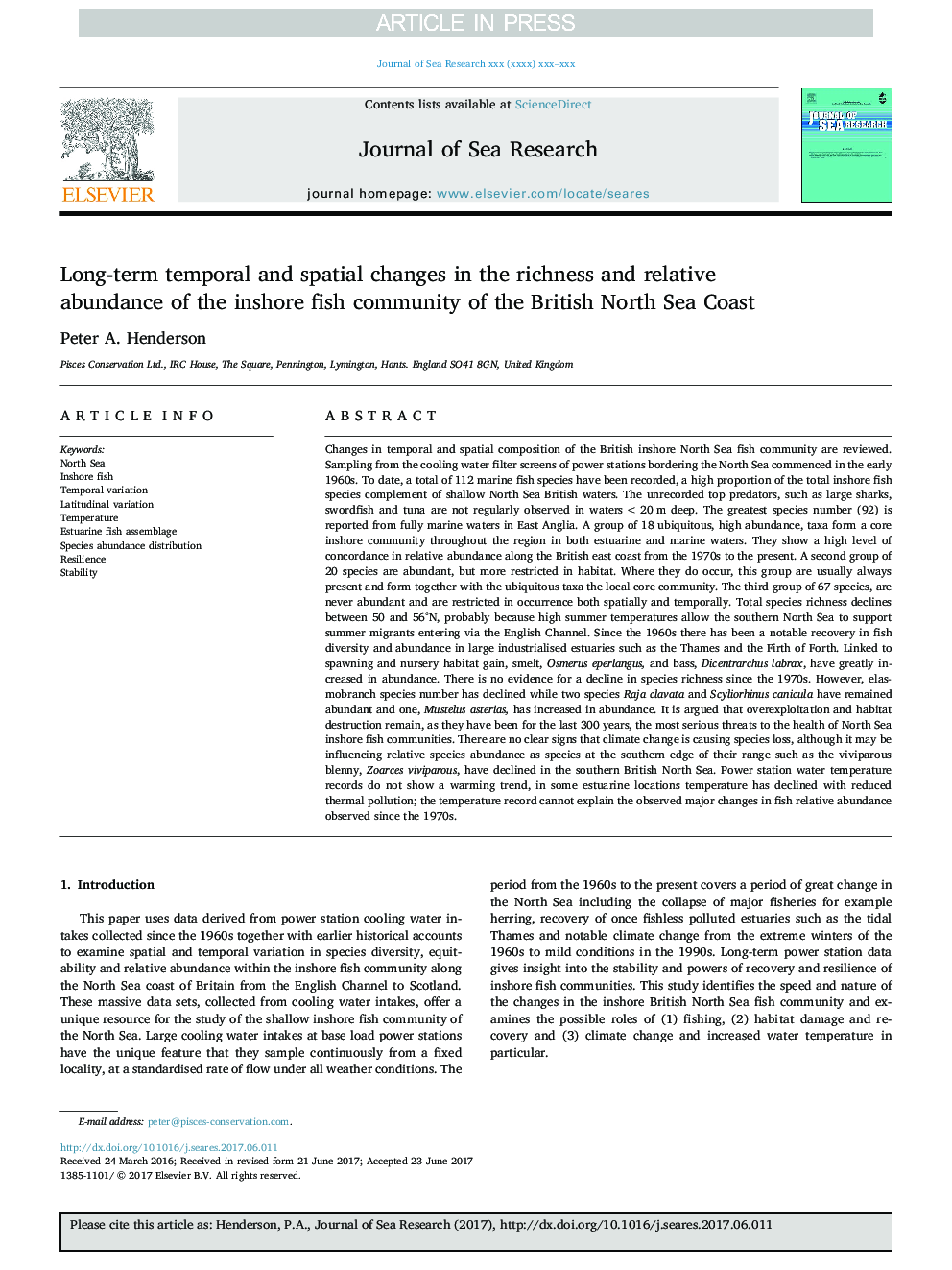| کد مقاله | کد نشریه | سال انتشار | مقاله انگلیسی | نسخه تمام متن |
|---|---|---|---|---|
| 5766105 | 1627448 | 2017 | 15 صفحه PDF | دانلود رایگان |
عنوان انگلیسی مقاله ISI
Long-term temporal and spatial changes in the richness and relative abundance of the inshore fish community of the British North Sea Coast
ترجمه فارسی عنوان
تغییرات زمانی و مکانی طولانی مدت در غنای و فراوانی نسبی جامعه ماهی ساحلی ساحل دریای شمال بریتانیا
دانلود مقاله + سفارش ترجمه
دانلود مقاله ISI انگلیسی
رایگان برای ایرانیان
کلمات کلیدی
دریای شمال، ماهی ساحلی، تنوع زمانی، تنوع عرضی، درجه حرارت، مجموعه ماهیان مصطفی، توزیع فراوانی گونه ها، انعطاف پذیری، ثبات،
موضوعات مرتبط
مهندسی و علوم پایه
علوم زمین و سیارات
اقیانوس شناسی
چکیده انگلیسی
Changes in temporal and spatial composition of the British inshore North Sea fish community are reviewed. Sampling from the cooling water filter screens of power stations bordering the North Sea commenced in the early 1960s. To date, a total of 112 marine fish species have been recorded, a high proportion of the total inshore fish species complement of shallow North Sea British waters. The unrecorded top predators, such as large sharks, swordfish and tuna are not regularly observed in waters < 20 m deep. The greatest species number (92) is reported from fully marine waters in East Anglia. A group of 18 ubiquitous, high abundance, taxa form a core inshore community throughout the region in both estuarine and marine waters. They show a high level of concordance in relative abundance along the British east coast from the 1970s to the present. A second group of 20 species are abundant, but more restricted in habitat. Where they do occur, this group are usually always present and form together with the ubiquitous taxa the local core community. The third group of 67 species, are never abundant and are restricted in occurrence both spatially and temporally. Total species richness declines between 50 and 56°N, probably because high summer temperatures allow the southern North Sea to support summer migrants entering via the English Channel. Since the 1960s there has been a notable recovery in fish diversity and abundance in large industrialised estuaries such as the Thames and the Firth of Forth. Linked to spawning and nursery habitat gain, smelt, Osmerus eperlangus, and bass, Dicentrarchus labrax, have greatly increased in abundance. There is no evidence for a decline in species richness since the 1970s. However, elasmobranch species number has declined while two species Raja clavata and Scyliorhinus canicula have remained abundant and one, Mustelus asterias, has increased in abundance. It is argued that overexploitation and habitat destruction remain, as they have been for the last 300 years, the most serious threats to the health of North Sea inshore fish communities. There are no clear signs that climate change is causing species loss, although it may be influencing relative species abundance as species at the southern edge of their range such as the viviparous blenny, Zoarces viviparous, have declined in the southern British North Sea. Power station water temperature records do not show a warming trend, in some estuarine locations temperature has declined with reduced thermal pollution; the temperature record cannot explain the observed major changes in fish relative abundance observed since the 1970s.
ناشر
Database: Elsevier - ScienceDirect (ساینس دایرکت)
Journal: Journal of Sea Research - Volume 127, September 2017, Pages 212-226
Journal: Journal of Sea Research - Volume 127, September 2017, Pages 212-226
نویسندگان
Peter A. Henderson,
